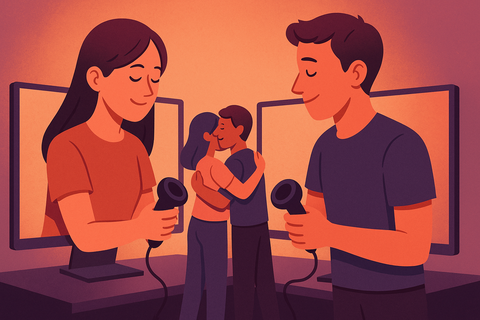Aug 19, 2025
Can Simulated Touch Help Us Feel More Connected?
Have you ever felt comforted by a hug after a tough day, or a hand on your shoulder when you were feeling left out? Touch is more than just a physical sensation. It’s a powerful social signal with the power to reduce stress and the perception of pain, but which can also enhance mood, intimacy and bonding.
But not everyone experiences touch the same way. For some, it’s soothing and enjoyable. For others, especially individuals with conditions like autism or those with traumatic experiences, touch can feel overwhelming or even unpleasant. So, what if we could simulate the benefits of touch without the discomfort of physical contact?
As we spend more time interacting in digital and virtual environments, this question becomes even more relevant: Can virtual or “pseudohaptic” touch offer emotional benefits without actual skin-to-skin contact?
Studies have shown that touch can reduce stress, ease pain, enhance mood, and even protect us from the effects of the social pain of rejection as shown with studies using the Cyberball game—a widely used psychological task that simulates social exclusion. In this game, participants play virtual catch with two others but are eventually ignored. Being excluded can trigger negative emotions and physiological stress. Interestingly, receiving comforting physical touch afterward can help restore emotional balance.
But what exactly is affective touch, and why does it matter?
Affective touch includes two components:
-
The sensory aspect, like the warmth and pressure of a caress on the skin.
-
The social aspect, or the emotional meaning behind the gesture, such as love, support, or congratulations.
Now, imagine caressing your own arm. You’d feel the physical sensation, but the emotional, social meaning would be missing. That distinction is important when thinking about how touch can be simulated or replaced in virtual spaces.
Differences in how people experience touch can stem from personality, neurodiversity (e.g., autism), or past trauma. For individuals who find touch overstimulating or unpleasant, could a simulated version of touch provide the benefits without the discomfort?
This is where virtual reality (VR) and pseudohaptics come in.
In our work with the ETC (Embodied Telepresent Connection) environment, developed by Prof. Bernhard E. Riecke’s group at Simon Fraser University, we explore how to simulate touch in VR without direct physical contact. Instead of skin-based stimulation, the system uses visual effects, sound cues, color changes, and simulated resistance to create the illusion of being touched.
Participants in this environment report feeling sensations such as tingling, warmth, and pressure, even though nothing is physically touching their skin. They interact with colorful avatars that are either controlled by another person (a social condition) or a mirrored version of themselves (a solo condition). This setup helps us tease apart the effects of the sensory and social components of touch.
In our ongoing research at ConTakt Lab, we are investigating whether pseudohaptic touch can reduce the emotional impact of social exclusion. We’re especially interested in how individuals’ personal attitudes toward touch influence their perception of simulated contact.
Our key questions:
-
Can people who dislike physical touch still benefit from simulated touch?
-
Does the social meaning of touch matter more than the physical sensation?
-
Are the benefits of touch greater when it comes from another person (social avatar) than from a self-reflection (mirror avatar)?
Could simulated touch offer a safe and meaningful alternative for people who struggle with real physical contact? As society increasingly moves towards remote interactions, identifying alternative ways to foster emotional connection becomes essential to maintaining psychological well-being.
We invite you to reflect with us:
Could pseudotouch change the way we connect in digital spaces? We’d love to hear your thoughts.
To learn more, follow our ongoing research at ConTakt Lab at our LinkedIn. To learn more about TU Dresden’s research on tactile technology, visit https://ceti.one/.

